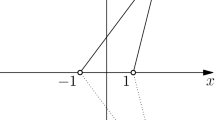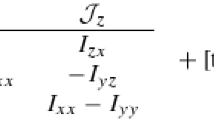Abstract
We propose a solution to the problem of time for systems with a single global Hamiltonian constraint. Our solution stems from the observation that, for these theories, conventional gauge theory methods fail to capture the full classical dynamics of the system and must therefore be deemed inappropriate. We propose a new strategy for consistently quantizing systems with a relational notion of time that does capture the full classical dynamics of the system and allows for evolution parametrized by an equitable internal clock. This proposal contains the minimal temporal structure necessary to retain the ordering of events required to describe classical evolution. In the context of shape dynamics (an equivalent formulation of general relativity that is locally scale invariant and free of the local problem of time) our proposal can be shown to constitute a natural methodology for describing dynamical evolution in quantum gravity and to lead to a quantum theory analogous to the Dirac quantization of unimodular gravity.


Similar content being viewed by others
Notes
For an analysis of approaches broadly constituted along these lines, we refer the reader to the recent reviews of Anderson [13, 14]. For a comprehensive modern text on canonical quantum gravity see [15]. The canonical formulation of general relativity was originally developed by Dirac [16] and Arnowitt, Deser and Misner (‘ADM’) [17, 18].
By conventional gauge theory methods we will understand: (i) Dirac quantization, (ii) reduced phase space quantization, and (iii) Faddeev–Popov gauge fixing, as outline in Sect. 2.
N.B. What we are proposing is only claimed to be a consistent methodology for the quantization of what is, under our definition, a relational theory. There are, of course, alternative types of quantization, just as there are alternative definitions of relationalism.
We are indebted to Tim Koslowski for helping to clarify this key point.
Here, and below, by equitable we will mean dependent upon the contributions of all the dynamical variables/subsystems of the system in question.
We are again indebted to Tim Koslowski for his valuable insight in regards to this extension procedure.
Second class constraints can always be made first class by a suitable redefinition of Ω following Dirac [26].
There is also a global requirement that Σ gf only intersects the gauge orbits once. We will assume that this requirement can be satisfied.
Crucially, this is the step that can be performed in shape dynamics that is highly non-trivial in the ADM formulation of general relativity.
This distinction constitutes a temporal orientation rather than a temporal direction, which would imply an arrow of time.
See [28, p. 280] for a analogous case.
In this section we will sometimes write the coordinates of p using lower case indices for convenience.
For an elegant treatment of both Jacobi and parameterized particle models the reader is referred to [46].
In particular, in GR it is still the case that standard gauge theory methods lead to a classical theory without even minimal temporal structure. See §3 of [48].
For simplicity, we will assume that Σ is compact without boundary.
The solutions must admit at least one foliation where the spatial Cauchy hypersurfaces have constant mean (extrinsic) curvature—i.e. be ‘CMC foliable.’ One may argue that all physically reasonable solutions will satisfy this condition which, in any case, is not dramatically stronger than the global hyperbolicity assumption that is fundamental to ADM GR.
References
Barbour, J.: The End of Time: The Next Revolution in Physics. Oxford University Press, London (2000)
Barbour, J.: The timelessness of quantum gravity: II. The appearance of dynamics in static configurations. Class. Quantum Gravity 11, 2875–2897 (1994)
Halliwell, J.J.: Trajectories for the wave function of the universe from a simple detector model. Phys. Rev. D 64, 044008 (2001). arXiv:gr-qc/0008046
Rovelli, C.: Quantum mechanics without time: a model. Phys. Rev. D 42, 2638–2646 (1990)
Rovelli, C.: Time in quantum gravity: an hypothesis. Phys. Rev. D 43, 442 (1991)
Rovelli, C.: Partial observables. Phys. Rev. D 65, 124013 (2002)
Dittrich, B.: Partial and complete observables for canonical general relativity. Class. Quantum Gravity 23, 6155 (2006)
Dittrich, B.: Partial and complete observables for hamiltonian constrained systems. Gen. Relativ. Gravit. 39, 1891 (2007)
Kiefer, C.: Wave packets in minisuperspace. Phys. Rev. D 38(6), 1761–1772 (1988)
Halliwell, J., Hartle, J.B.: Wave functions constructed from an invariant sum over histories satisfy constraints. Phys. Rev. D 43(4), 1170–1194 (1991)
Halliwell, J.J., Thorwart, J.: Life in an energy eigenstate: decoherent histories analysis of a model timeless universe. Phys. Rev. D 65, 104009 (2002). arXiv:gr-qc/0201070
Halliwell, J.J.: Probabilities in quantum cosmological models: a decoherent histories analysis using a complex potential. Phys. Rev. D 80, 124032 (2009)
Anderson, E.: The problem of time in quantum gravity. arXiv:1009.2157 [gr-qc]
Anderson, E.: The problem of time and quantum cosmology in the relational particle mechanics arena. arXiv:1111.1472v1
Thiemann, T.: Modern Canonical Quantum General Relativity. Cambridge University Press, Cambridge (2007)
Dirac, P.A.M.: The theory of gravitation in hamiltonian form. Proc. R. Soc. Lond. Ser. A, Math. Phys. Sci. 246, 333–343 (1958)
Arnowitt, R., Deser, S., Misner, C.W.: Canonical variables for general relativity. Phys. Rev. 117, 1595–1602 (1960). http://link.aps.org/doi/10.1103/PhysRev.117.1595
Arnowitt, R., Deser, S., Misner, C.W.: The dynamics of general relativity. In: Witten, L. (ed.) Gravitation: An Introduction to Current Research, pp. 227–265. Wiley, New York (1962), Chap. 7
Kuchar, K.: The problem of time in canonical quantization of relativistic systems. In: Ashtekar, A., Stachel, J. (eds.) Conceptual Problems of Quantum Gravity, p. 141. Boston University Press, Boston (1991)
Kuchar, K.: Time and interpretations of quantum gravity. In: 4th Canadian Conference on General Relativity…. World Scientific, Singapore (1992)
Kuchař, K.V.: Canonical quantum gravity. In: Gleiser, R.J., Kozameh, C.N., Moreschi, O.M. (eds.) General Relativity and Gravitation 1992, p. 119 (1993). arXiv:gr-qc/9304012
Kuchar, K.: The problem of time in quantum geometrodynamics. In: Butterfield, J. (ed.) The Arguments of Time, pp. 169–195 (1991)
Thébault, K.P.Y.: Quantisation, representation and reduction; how should we interpret the quantum hamiltonian constraints of canonical gravity? Symmetry 3, 134 (2011)
Gomes, H., Gryb, S., Koslowski, T.: Einstein gravity as a 3D conformally invariant theory. Class. Quantum Gravity 28, 045005 (2011). arXiv:1010.2481 [gr-qc]
Gomes, H., Koslowski, T.: The link between general relativity and shape dynamics. arXiv:1101.5974 [gr-qc]
Dirac, P.A.M.: Lectures on Quantum Mechanics. Dover, New York (1964)
Barbour, J.B.: The timelessness of quantum gravity. 1: The evidence from the classical theory. Class. Quantum Gravity 11, 2853–2873 (1994)
Henneaux, M., Teitelboim, C.: Quantization of Gauge Systems. Princeton University Press, Princeton (1992)
Barbour, J., Foster, B.Z.: Constraints and gauge transformations: Dirac’s theorem is not always valid. arXiv:0808.1223 [gr-qc]
Faddeev, L.D.: The Feynman integral for singular lagrangians. Theor. Math. Phys. 1(1), 1–13 (1969)
Gotay, M.J.: Constraints, reduction, and quantization. J. Math. Phys. 27, 2051–2066 (1986)
Arnold, V.I., Kozlov, V.V., Neishtadt, A.I.: Mathematical Aspects of Celestial Mechanics. Springer, Berlin (1988)
Souriau, J.: Structure of Dynamical Systems: A Symplectic View of Physics. Birkhäuser, Basel (1997)
Faddeev, L.D.: Feynman integral for singular lagrangians. Theor. Math. Phys. 1, 1–13 (1969)
Guillemin, V., Sternberg, S.: Geometric quantization and multiplicities of group representations. Invent. Math. 67(3), 515–538 (1982)
Rovelli, C.: Quantum Gravity. Cambridge University Press, Cambridge (2004)
Gerlach, U.H.: Derivation of the ten Einstein field equations from the semiclassical approximation to quantum geometrodynamics. Phys. Rev. 177, 1929–1941 (1969)
Mach, E.: Die Mechanik in Ihrer Entwicklung Historisch-Kritsch Dargestellt. Barth, Leipzig (1883). English transl.: Mach, E., The Science of Mechanics, Open Court, Chicago (1960) (transl. of 1912 German edn.)
Mittelstaedt, P.: Der Zeitbegriff in der Physik. B.I.-Wissenschaftsverlag, Mannheim (1976)
Barbour, J.B., Pfister, H. (eds.): Mach’s Principle: From Newton’s Bucket to Quantum Gravity. Proceedings, Conference, Tuebingen, Germany, July 26–30, 1993. Birkhäuser, Boston (1995), 536 pp. (Einstein studies. 6)
Marolf, D.: Almost ideal clocks in quantum cosmology: a brief derivation of time. Class. Quantum Gravity 12, 2469–2486 (1995). arXiv:gr-qc/9412016 [gr-qc]
Marolf, D.: Solving the problem of time in mini-superspace: measurement of Dirac observables. Phys. Rev. D 79, 084016 (2009). arXiv:0902.1551 [gr-qc]
Giddings, S.B., Marolf, D., Hartle, J.B.: Observables in effective gravity. Phys. Rev. D 74, 064018 (2006). arXiv:hep-th/0512200 [hep-th]
Bojowald, M., Hoehn, P.A., Tsobanjan, A.: An effective approach to the problem of time. Class. Quantum Gravity 28, 035006 (2011). arXiv:1009.5953 [gr-qc]
Hilgevoord, J.: Time in quantum mechanics: a story of confusion. Stud. Hist. Philos. Sci. Part B: Stud. Hist. Philos. Mod. Phys. 36(1), 29–60 (2005)
Lanczos, C.: The Variational Principles of Mechanics. Dover, New York (1970)
Teitelboim, C.: How commutators of constraints reflect the spacetime structure. Ann. Phys. 79(2), 542–557 (1973). http://www.sciencedirect.com/science/article/pii/0003491673900961
Thebault, K.P.Y.: Three denials of time in the interpretation of canonical gravity (2011). http://philsci-archive.pitt.edu/8774/
Brown, J.D., York, J.W.J.: Jacobi’s action and the recovery of time in general relativity. Phys. Rev. D 40, 3312–3318 (1989)
Henneaux, M., Teitelboim, C.: The cosmological constant and general covariance. Phys. Lett. B 222, 195–199 (1989)
Unruh, W.G.: A unimodular theory of canonical quantum gravity. Phys. Rev. D 40, 1048 (1989)
Unruh, W.G., Wald, R.M.: Time and the interpretation of canonical quantum gravity. Phys. Rev. D 40, 2598 (1989)
Barbour, J.: Shape dynamics. An introduction. arXiv:1105.0183
Gryb, S.: Shape dynamics and Mach’s principles: gravity from conformal geometrodynamics. Ph.D. thesis, University of Waterloo (2011). Available at http://www.uwspace.uwaterloo.ca/handle/10012/6124
Gomes, H., Gryb, S., Koslowski, T., Mercati, F.: The gravity/CFT correspondence. arXiv:1105.0938 [gr-qc]
York, J.J.W.: Role of conformal three geometry in the dynamics of gravitation. Phys. Rev. Lett. 28, 1082–1085 (1972)
Gryb, S.B.: A definition of background independence. Class. Quantum Gravity 27, 215018 (2010). arXiv:1003.1973 [gr-qc]
Sorkin, R.D.: Forks in the road, on the way to quantum gravity. Int. J. Theor. Phys. 36, 2759–2781 (1997). arXiv:gr-qc/9706002
Daughton, A., Louko, J., Sorkin, R.D.: Initial conditions and unitarity in unimodular quantum cosmology. arXiv:gr-qc/9305016
Smolin, L.: The quantization of unimodular gravity and the cosmological constant problem. arXiv:0904.4841 [hep-th]
Kuchar, K.V.: Does an unspecified cosmological constant solve the problem of time in quantum gravity? Phys. Rev. D 43, 3332–3344 (1991)
Acknowledgements
We would like to thank Julian Barbour for helpful comments and criticisms and Lee Smolin for encouraging us to look more closely at the Hamilton–Jacobi formalism. We would also like to thank the participants of the 2nd PIAF conference in Brisbane (in particular Hans Westman) for their inspiring questions on the problem of time. Finally, we would like to extend a special thanks to Tim Koslowski for many useful discussions and for making valuable contributions to our overall understanding of this work. Research at the Perimeter Institute is supported in part by the Government of Canada through NSERC and by the Province of Ontario through MEDT.
Author information
Authors and Affiliations
Corresponding author
Rights and permissions
About this article
Cite this article
Gryb, S., Thébault, K. The Role of Time in Relational Quantum Theories. Found Phys 42, 1210–1238 (2012). https://doi.org/10.1007/s10701-012-9665-5
Received:
Accepted:
Published:
Issue Date:
DOI: https://doi.org/10.1007/s10701-012-9665-5




